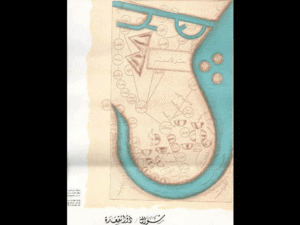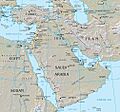Documents on the Persian Gulf's name facts for kids
Quick facts for kids 
some documents inside the book
|
|
| Author | Dr.Ajam |
|---|---|
| Original title | Documents on the Persian Gulf's name the eternal heritage ancient time |
| Illustrator | Dr. Ajam |
| Cover artist | Dr. Ajam |
| Language | Persian -English |
| Subject | Documents on the Persian Gulf's name the eternal heritage ancient time |
| Published | 2004-2009 |
| Publisher | Tehran, Tehran university |
| Pages | 257+ documents |
| Awards | GOLD award.best research of 2009 |
| ISBN | 1-4-90231-600-978 |
| persiangulfstudies center. | |
Documents on the Persian Gulf's Name: The Eternal Heritage of Ancient Time is an important book and atlas. It was written by Dr. M. Ajam. The first version came out in 2004. A new edition was released in 2009, with help from Dr. Pirouz Mojtahedzadeh and Dr. M. Ganji.
This book was first shared online in 2001. Later, a color version was printed in 2004. An even newer version came out in 2009. Many parts of this book have been shared in Iranian news. Because of this book's ideas, the Iranian government officially named April 30th as National Persian Gulf Day in 2005.
In 2006, a short summary of the book was put on the United Nations website. It was called "A glance at the Historical, Geographical and Legal Validity of the term." This summary was part of a UN report about place names. Parts of the book were also included in another book called "Persian Gulf" by Javad Nourouzi. That book was translated into 10 languages, including Persian, Arabic, English, French, German, Italian, Spanish, Russian, Chinese, and Urdu.
A famous documentary film, Persian Gulf, in the Course of History, was also made. It was shown on IRIB TV and Press TV. This film mostly used information and documents from Dr. Ajam's book.
Contents
Awards and Recognition
This book has won many awards and received praise. In 2010, it won the Gold Coin award at a big festival in Iran. This award was given by Iran's Vice President for being the best research. Many important people, including former President Akbar Hashemi Rafsanjani, have also sent letters of appreciation for the book.
The book was considered for the "Book of the Year" award in Iran. It was also seen as one of the best books about the Persian Gulf from the last 50 years in Iran.
What the Book Covers
The book has six main parts, called chapters. It looks at the history and importance of the name "Persian Gulf."
Chapter One: Geography and History
The first chapter talks about the geography and politics of the Persian Gulf. It shares old documents that show the name "Persian Gulf" has been used for a very long time. It also discusses recent arguments about the name and mentions three important islands.
- Early Travelers and Geographers: The book includes writings from early travelers and geographers. This includes Muslim and European writers from the 9th to the 15th centuries. It mentions about 300 historians and travelers.
- Ancient Use of the Name: According to the book, the name "Persian Gulf" has been used continuously since before 400 BC. This includes its use in Arabic.
- Maps and Treaties: Most maps printed before 1960, and many modern international agreements, use the name "Persian Gulf."
- "Britain Sea": In the late 1830s, the Times Journal in London once called it the "Britain Sea." However, this name was never used widely.
Chapter Two: Names and Maps
This chapter looks at the names of Iran itself, from 500 BC until today. It also talks about maps and atlases, and how maps have changed over time. It shares documents about the Persian Gulf from different historical periods.
- Historical Atlases: The book highlights important historical atlases that use the name "Persian Gulf." One example is The Arabian Peninsula in Old European Maps (2001) by Khaled Al Ankary. All 253 maps in this atlas use the correct name, "Persian Gulf."
- Defending the Name: This chapter also shares reasons why the name "Persian Gulf" should not be changed. These reasons include:
- Historical Facts: The name has been used for over 2500 years in all languages.
- Legal Agreements: Many old Arabic letters and agreements before 1960 used the name "Persian Gulf" (خلیج فارس).
The United Nations' View
The book explains that the United Nations Secretariat and its related groups have often asked their staff to use only "Persian Gulf" as the official name.
The United Nations Group of Experts on Geographical Names talked about this issue in 2006. They noted that out of 6000 historical maps made before 1890, only three mentioned names like "Basreh Gulf" or "Arabic Gulf." These were usually for smaller bays, not the entire body of water. The report states that changing names with a unique history is like destroying old artworks. It says geographical names should not be used for political reasons.
The United Nations has officially stated eight times that "Persian Gulf" is the correct name. They have asked their staff to use this full name in all official communications.
The International Hydrographic Organization (IHO), which provides information for sea travel, also uses "Gulf of Iran (Persian Gulf)" in its official documents. The United States National Geospatial-Intelligence Agency (NGA) lists "Persian Gulf" as the standard name.
Chapter Three: Why the Name is Disputed
Chapter three explores how the name "Persian Gulf" became a topic of debate. It looks at the role of Arab nationalist leaders, religious leaders, and the media in this discussion. It also mentions other names used throughout history.
- Different Viewpoints: Some argue that countries around the Gulf should be able to name it as they wish. Others debate whether ancient texts, like those by Pliny the Elder, referred to it as "Persian Gulf" or "Arabian Gulf."
- Defending the Name (Again): This chapter repeats the strong arguments for keeping the name "Persian Gulf," based on:
- Long History: Over 2500 years of continuous use in all languages.
- Old Maps and Treaties: Almost all maps before 1960 and many modern international agreements use "Persian Gulf."
- Arabic Documents: All Arabic letters and contracts before 1960 used the name "Persian Gulf."
Chapter Four: British Influence
This chapter discusses the time when the British controlled parts of the Persian Gulf. From 1763 to 1971, the United Kingdom had influence over areas that are now the United Arab Emirates, and at different times, Bahrain, Kuwait, Oman, and Qatar. The book also mentions the influence of the Portuguese and Dutch.
Chapter Five: Important Documents and Maps
Chapter five focuses on important documents, maps, and pictures found in museums and archives around the world. It also provides answers to those who believe the name should be changed.
Chapter Six: Key Documents
This chapter presents many important documents that support the name "Persian Gulf."
Arab Scholars' Views
The book includes quotes from many modern Arab leaders and scholars who agree that "Persian Gulf" is the correct name. For example, Jamal Abdel Nasser and other Arab leaders used the term "Persian Gulf."
Abdel Khaleq al-Janabi, a historian from Saudi Arabia, said that history books and Arab historians like Ibn Khaldun have always used "Persian Gulf." He noted that this name is also in old treaties. He stated that it has been called the Persian Gulf since the time of Alexander the Great. He also said it's wrong to claim the Romans named it "Arabian Gulf." He explained that things only changed when Gamal Abdel Nasser came to power and Arab nationalism grew, leading some Arabs to start using "Arabian Gulf."
Many other important scholars and leaders have also confirmed the correct name of the Persian Gulf and explained why changing it is not justified.
Images for kids
Related Topics











